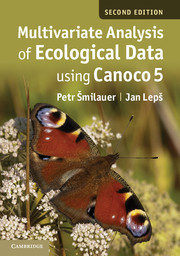Book contents
- Frontmatter
- Contents
- Preface
- 1 Introduction and data types
- 2 Using Canoco 5
- 3 Experimental design
- 4 Basics of gradient analysis
- 5 Permutation tests and variation partitioning
- 6 Similarity measures and distance-based methods
- 7 Classification methods
- 8 Regression methods
- 9 Interpreting community composition with functional traits
- 10 Advanced use of ordination
- 11 Visualising multivariate data
- 12 Case study 1: Variation in forest bird assemblages
- 13 Case study 2: Search for community composition patterns and their environmental correlates: vegetation of spring meadows
- 14 Case study 3: Separating the effects of explanatory variables
- 15 Case study 4: Evaluation of experiments in randomised complete blocks
- 16 Case study 5: Analysis of repeated observations of species composition from a factorial experiment
- 17 Case study 6: Hierarchical analysis of crayfish community variation
- 18 Case study 7: Analysis of taxonomic data with discriminant analysis and distance-based ordination
- 19 Case study 8: Separating effects of space and environment on oribatid community with PCNM
- 20 Case study 9: Performing linear regression with redundancy analysis
- Appendix A Glossary
- Appendix B Sample data sets and projects
- Appendix C Access to Canoco and overview of other software
- Appendix D Working with R
- References
- Index to useful tasks in Canoco 5
- Subject index
19 - Case study 8: Separating effects of space and environment on oribatid community with PCNM
Published online by Cambridge University Press: 05 May 2014
- Frontmatter
- Contents
- Preface
- 1 Introduction and data types
- 2 Using Canoco 5
- 3 Experimental design
- 4 Basics of gradient analysis
- 5 Permutation tests and variation partitioning
- 6 Similarity measures and distance-based methods
- 7 Classification methods
- 8 Regression methods
- 9 Interpreting community composition with functional traits
- 10 Advanced use of ordination
- 11 Visualising multivariate data
- 12 Case study 1: Variation in forest bird assemblages
- 13 Case study 2: Search for community composition patterns and their environmental correlates: vegetation of spring meadows
- 14 Case study 3: Separating the effects of explanatory variables
- 15 Case study 4: Evaluation of experiments in randomised complete blocks
- 16 Case study 5: Analysis of repeated observations of species composition from a factorial experiment
- 17 Case study 6: Hierarchical analysis of crayfish community variation
- 18 Case study 7: Analysis of taxonomic data with discriminant analysis and distance-based ordination
- 19 Case study 8: Separating effects of space and environment on oribatid community with PCNM
- 20 Case study 9: Performing linear regression with redundancy analysis
- Appendix A Glossary
- Appendix B Sample data sets and projects
- Appendix C Access to Canoco and overview of other software
- Appendix D Working with R
- References
- Index to useful tasks in Canoco 5
- Subject index
Summary
In this case study, you will learn how to test for existence of spatial structuring of the variation in biotic community composition and how to correctly test for the effects of environment upon community composition when the spatial effects are present in your data, manifested as a spatial correlation among the sampling locations. We also show how to quantify the spatially structured and spatially non-structured fractions of the community variation explained by the environment and the spatial variation in the community composition not related to the environment, and how to visualise these fractions.
You will use a data set first published by Borcard et al. (1992) and describing oribatid mite community in a peat bog. The data set is based on 70 substrate cores, accompanied by measured environmental variables, characterising local conditions: peat density, water contents, substrate type, relief type, and shrub cover. These data are present in the first two data tables of the Oribatida.c5p project: the Oribatids data table with the counts of 35 oribatid taxa and the Environment table with environmental descriptors. The third data table (named Coordinates) stores the X and Y coordinates describing the spatial position of each core within the sampled area, which was 2.5 metres wide and 10 metres long. The additional, Xc and Yc variables represent the centred (i.e. with a zero average) versions of X and Y, and Xc^2 and Yc^2 are the centred second powers of Xc and Yc, respectively. Their use is explained in Section 19.2. Alternatively, you can import the data from the three sheets of the Oribatids.xlsx spreadsheet file. Please note that the data table in the first sheet (Species) must be transposed during the import, as the cores are represented by columns.
- Type
- Chapter
- Information
- Multivariate Analysis of Ecological Data using CANOCO 5 , pp. 324 - 336Publisher: Cambridge University PressPrint publication year: 2014
- 1
- Cited by



